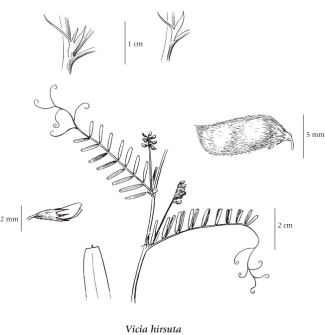Vicia hirsuta (L.) Gray
tiny vetch (hairy vetch)
Fabaceae (Pea family)
Introduction to Vascular Plants
tiny vetch (hairy vetch)
Fabaceae (Pea family)
Introduction to Vascular Plants
Species Information
General:
Annual herb from a taproot; stems climbing or decumbent, 30-70 cm tall/long, slender, 4-angled, grooved, glabrous to finely hairy.
Leaves:
Alternate, pinnately compound; leaflets 12 to 18, linear to narrowly elliptic, 0.5-2 cm long, squared-off and notched or 1- to 5-toothed at the tip; tendrils well developed, usually branched, grasping; stipules linear, 2-5 mm long, lobed at the base,.
Flowers:
Inflorescence a short-stalked raceme of 3 to 8 pea-like flowers, generally shorter than the subtending leaf; corollas whitish to pale blue, 3-4 mm long; calyx teeth lanceolate, about equal to the tube.
Fruits:
Pods, broadly oblong or elliptic, hairy, 1 cm long; seeds usually 2.
Illustration

If more than one illustration is available for a species (e.g., separate illustrations were provided for two subspecies) then links to the separate images will be provided below. Note that individual subspecies or varietal illustrations are not always available.
Illustration Source: The Illustrated Flora of British Columbia
Ecology
Ecological Framework for Vicia hirsuta
The table below shows the species-specific information calculated from
original data (BEC database) provided by the BC Ministry of Forests and Range.
(Updated August, 2013)
The table below shows the species-specific information calculated from
original data (BEC database) provided by the BC Ministry of Forests and Range.
(Updated August, 2013)
| Site Information |
Value / Class |
||
|
Avg |
Min |
Max |
|
| Elevation
(metres) |
110 | 15 | 315 |
| Slope
Gradient (%) |
36 | 0 | 105 |
|
Aspect (degrees) |
196 | 45 | 360 |
| Soil
Moisture Regime (SMR) [0 - very xeric; 4 - mesic; 8 - hydric] |
1 | 1 | 3 |
| Modal
Nutrient Regime
Class |
D | ||
| #
of field plots species was recorded in: |
34 | ||
| Modal
BEC Zone Class |
CDF | ||
|
All BEC Zones (# of stations/zone) species was recorded in |
CDF(28) | ||
|
Source:
Klinkenberg 2013
|
|||